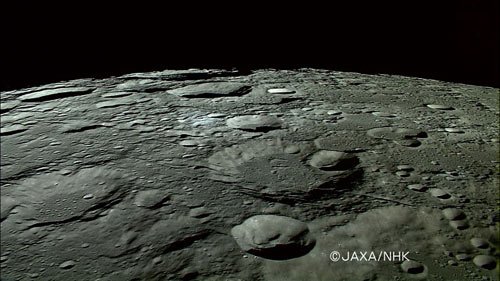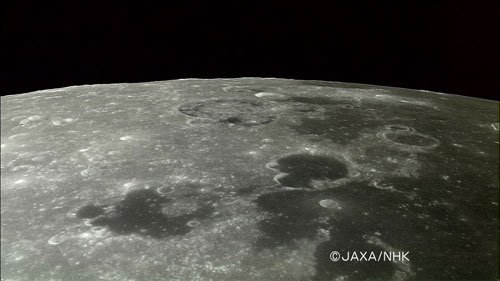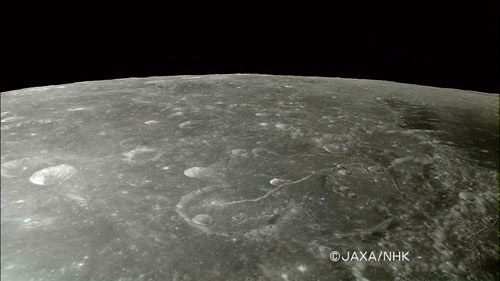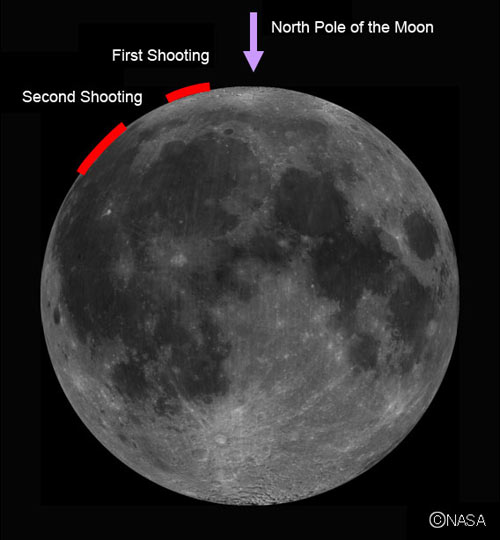Japanische Raumfahrtagentur JAXA macht Bilder vom Mond in HDTV
The Japan Aerospace Exploration Agency (JAXA) and NHK (Japan Broadcasting Corporation) have successfully performed the world’s first high-definition image taking by the lunar explorer „KAGUYA“ (SELENE,) which was injected into a lunar orbit at an altitude of about 100 km on October 18, 2007, (Japan Standard Time. Following times and dates are all JST.)
The image shooting was carried out by the onboard high definition television (HDTV) of the KAGUYA, and it is the world’s first high definition image data acquisition of the Moon from an altitude about 100 kilometers away from the Moon.
The image taking was performed twice on October 31. Both were eight-fold speed intermittent shooting (eight minutes is converged to one minute.) The first shooting covered from the northern area of the „Oceanus Procellarum“ toward the center of the North Pole, then the second one was from the south to the north on the western side of the „Oceanus Procellarum.“ The moving image data acquired by the KAGUYA was received at the JAXA Usuda Deep Space Center, and processed by NHK.
The satellite was confirmed to be in good health through telemetry data received at the Usuda station.

North Pole Area (still image cut out from the first image shooting)
This is a still image taken out from the first moving image shooting when the KAGUYA flew from the northern area of the „Oceanus Procellarum“(*1) to the center of the North Pole.
As the altitude near the North Pole is high, the angle of the coming sunlight was lower, thus the shade of the crater topography looks long in the image.
The moving image was taken at 4:07 a.m. on October 31, 2007 (JST) by eight-fold speed intermittent shooting (eight minutes is converged to one minute) from the KAGUYA, and the data was received at the JAXA Usuda Deep Space Center on the same day.
(*1) Oceanus Procellarum:
The dark area on the Moon’s surface called „ocean.“ It is located at the left end of the northern hemisphere on the front side of the Moon when we look up at it from the Earth.

(2) The western side of the „Oceanus Procellarum“ (cut out from the second image shooting)
This is a still image taken out from the second moving image shooting when the KAGUYA flew from the south to the north on the western side of the „Oceanus Procellarum.“
The dark part on the right of the above image is the Ocean (Oceanus Procellarum,) and the light area on the left is called the „highland.“
The moving image was taken at 5:51 a.m. on Oct. 31, 2007 (JST) by eight-fold speed intermittent shooting (eight minutes is converged to one minute) from the KAGUYA, and the data was received at the JAXA Usuda Deep Space Center on the same day.

(3) The west side of the „Oceanus Procellarum“ (cut out from the second image shooting)
This is a still image taken out from the end part of the second moving image taking.
We can observe a crater called „Repsold,“ whose diameter is 107 km, at the center on the near side of this image. The channel that crosses this crater is called the „Repsold Valley,“ and its length is about 180 km (equivalent to the distance between Tokyo and Shizuoka on the Tokaido Line in Japan.) The shooting time was the same as the above (2.)

Weblink:
www.jaxa.jp
www.lpi.usra.edu/resources/mapcatalog/LMP/
www.nasa.gov

